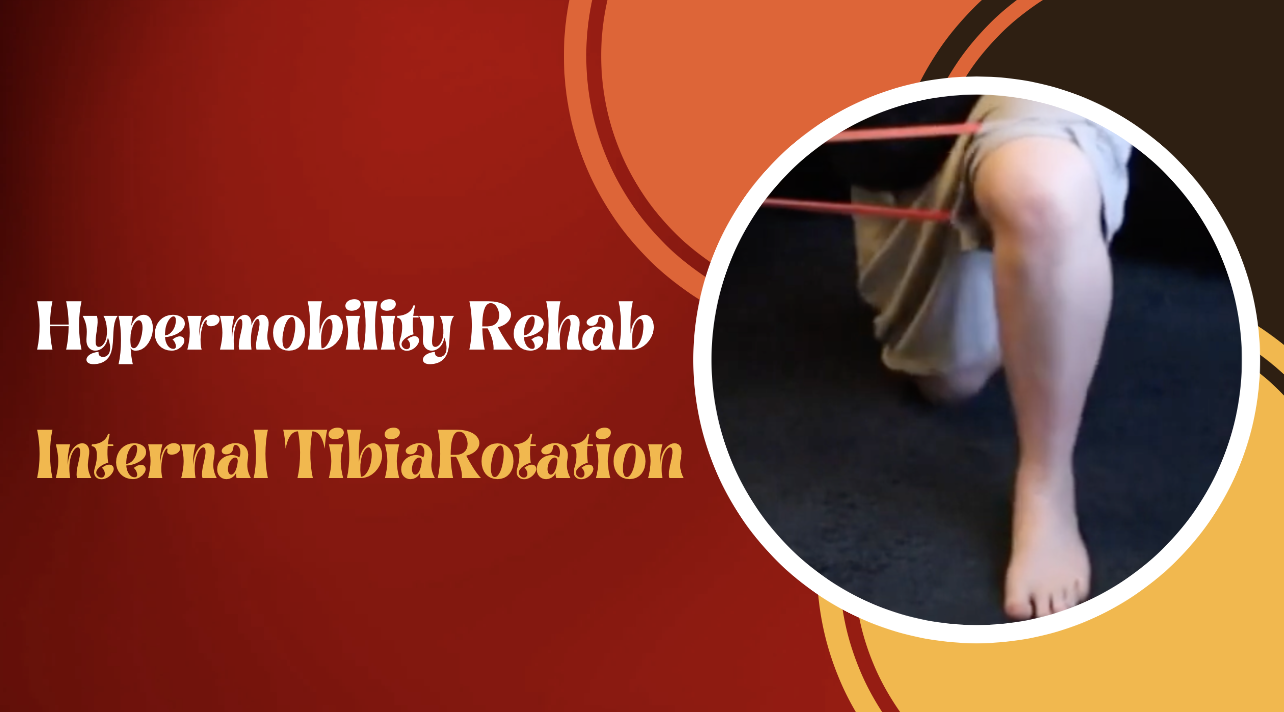- Internal Tibial Rotation Exercises for Hypermobility: Improve Knee & Ankle Stability - 20 November 2025
- What Causes chronic pain in Fibromyalgia and Hypermobility - 27 June 2025
- Mast Cells and Fibromyalgia: The Hidden Connection - 19 June 2025
If your knees feel like they’re always one step behind the rest of your body, or your ankles like to give way even when you’re standing still, then you’re in the right place. It’s something we see all the time. Wobbly knees, ankles that roll for no reason. A sense that no matter how much you stretch or strengthen, something just feels off.
For those of us with hypermobility, stability is never just about strength. It’s about control. It’s about the brain knowing exactly where your joints are, and being able to react in real time. And there’s one particular movement that tends to fly under the radar, but has a huge impact on both the knees and the ankles. That movement is internal tibial rotation.
Now, I get it. It doesn’t sound like the most exciting thing in the world. But it is one of those subtle, essential movements that helps to keep the knee joint stable, the ankle moving well, and everything stacked in the right place. When you lose it, you end up with all sorts of problems. From poor proprioception, to increased pain, to knees that just will not behave.
In this blog, we’re going to break down exactly what internal tibial rotation is, why it matters, and how it gets disrupted in hypermobility. We’ll also look at the muscles involved, how the feet and ankles are linked to it, and what this all looks like in daily life. If you’ve ever wondered why your knees cave in, or why your balance is all over the place, this will start to make a lot more sense.
Further down, you’ll find a video where I walk you through the exact exercises I use to help retrain this movement with our clients. These are not random stretches or strength drills. They are targeted, progressive movements designed to help your brain rebuild the map it needs to keep your joints under control.
So, if you’ve been stuck with unstable knees or ankles and nothing has really helped, then this might just be the piece you’ve been missing.
This article covers:
ToggleWhat Is Internal Tibial Rotation And Why Should You Care
Internal tibial rotation is one of those movements that most people never think about. But once it starts going wrong, it can quietly cause chaos.
Put simply, internal tibial rotation is when your shin bone rotates inward under your thigh bone. This movement happens when the knee bends, particularly during walking, squatting, or changing direction. It helps to unlock the knee joint so that it can move smoothly and absorb force properly. It also allows the ankle and foot to move in a more coordinated way.
The trouble is, you cannot actually rotate your tibia internally when the knee is fully straight. The movement only happens when the knee is bent. This is important because a lot of instability problems come from trying to control motion in a bent position, like when walking downstairs or getting up from the floor. If your tibia is not able to rotate inwards properly, your knee has to compensate somewhere else. And so does your ankle. And so does your hip. This is also important when Hypermobile because you’ll want to lock your knees for that feeling of “Stability” see the problem?
Internal tibial rotation is not just a small movement. It is a key part of how your knee absorbs load. If that rotation does not happen well, the load has to go somewhere else. Over time, that can mean more pressure through the medial side of the knee, more tension in the muscles, and an increased risk of subluxation. It can also start to affect how the foot hits the ground, especially if there is already some pronation or ankle laxity going on.
So why should you care about all of this? Because when this movement is missing or poorly controlled, you often end up with knees that feel wobbly and unpredictable. You might start to notice pain with activities that never used to bother you. Or feel like your body has to work harder just to stay upright.
This is especially important if you are hypermobile. Hypermobility changes how the brain processes joint position, and rotational movements like this are often the first to become unclear. You are not just dealing with muscles that are weak. You are dealing with a system that cannot clearly sense where things are, or how to react when they move.
The Problem with Hypermobility and Tibial Rotation
When you’re hypermobile or have Ehlers Danlos Syndrome, rotational control tends to be one of the first things to go. It’s subtle, and it often slips through the cracks because it doesn’t show up on a standard strength test. But rotational instability, especially at the tibia, can have a knock on effect across the entire lower limb.
In a typical knee, internal tibial rotation happens naturally as part of walking, bending, and weight transfer. But in a hypermobile knee, the connective tissue that helps guide and restrain this movement is often too lax to provide any real control. The result is that the tibia either rotates too much, not enough, or at the wrong time altogether.
Research shows that those with generalised joint hypermobility often demonstrate increased tibial rotational velocity during knee extension. In simpler terms, the shin rotates faster and less predictably than it should. This creates what we call rotational instability. And the more rotational instability you have, the more likely you are to experience things like knee subluxations, patellar tracking problems, and increased strain on the ligaments.
This is where proprioception comes into the picture. If you’re hypermobile, your ability to sense joint position is often reduced. That means your brain has to guess where the knee is, especially during quick or unexpected movements. If that guess is wrong, and internal tibial rotation is uncontrolled, it leaves the knee vulnerable to slipping or collapsing under load.
But the knee is not the only joint affected here. Because of the close relationship between the foot, ankle, and tibia, changes in rotation at the shin can also disrupt the ankle. For example, too much internal rotation can place more strain on the medial structures of the ankle. Too little rotation can limit the natural coupling that happens between the foot and lower leg during walking. Either way, you end up with instability at both joints.
It’s also important to understand that this instability is not just about strength. You can have strong muscles and still lack control. What we are talking about here is timing, coordination, and mapping. When your brain doesn’t know where the tibia is or how fast it is rotating, it cannot create the stabilising responses that are needed in real time. And without those responses, the knee becomes a lot harder to trust.
So, if your knees feel wobbly when walking, or your ankle rolls out even on flat ground, there’s a good chance that your tibial rotation is not being well controlled. And if you’ve been trying to fix that with general balance drills or open chain exercises, you may have missed the mark.
This is not about doing more. It’s about doing the right thing in the right order.
The Muscles Behind Tibial Rotation
When we talk about tibial rotation, especially in the context of hypermobility, it’s important to remember that muscles are not just about force. They are also about timing and control. And when the muscles that help rotate the tibia are out of sync, the whole knee becomes less predictable.
The main muscle responsible for internal tibial rotation is the popliteus. It’s a small but incredibly important muscle that sits behind the knee. It acts almost like a key, unlocking the joint as the knee bends. In fact, during walking, popliteus activity begins just before the heel hits the ground. That early activation helps prepare the knee for the load it is about to take. Without it, the joint stays locked for too long or rotates at the wrong time.
Alongside the popliteus, we have the medial hamstrings. Specifically, the semitendinosus and semimembranosus. These muscles also contribute to internal rotation of the tibia, especially when the foot is not fixed on the ground. But here’s where it gets interesting. In many people with hypermobility, these muscles tend to be underactive, while the lateral hamstring, the biceps femoris, tends to do more than its fair share.
The biceps femoris contributes to external tibial rotation. And when it dominates, you get a force that pulls the tibia in the opposite direction. This makes internal rotation harder to access and can lead to patterns that increase instability around the knee. It also reduces the natural ability of the brain to correct small positional errors quickly, because it is relying on the wrong muscles to do the job.
You might notice this when doing simple movements. Things like squats that feel awkward or knees that drift outward without you really meaning to. You might also feel tension in the outer part of the knee or the lateral hamstring during tasks that should not be using them that much. These are signs that the internal rotators are not pulling their weight.
It’s also worth mentioning the deeper hip and ankle muscles here. Because even though this section is about the knee, everything around it still matters. Weakness or timing issues in muscles like the gluteus medius or tibialis posterior can indirectly impact tibial control. They help manage the forces that pass through the leg when walking, and if they are not doing their job well, the knee ends up with more than it can handle.
In short, if the right muscles are not firing at the right time, then no amount of stretching or strengthening is going to bring the stability you are looking for. The key is not just knowing which muscles are involved, but retraining the sequence in which they work. That is what starts to build the control that is often missing in hypermobility.
And that is exactly what we are going to begin working on soon.
The Ankle-Foot Connection
When we talk about tibial rotation, it’s easy to get stuck thinking just about the knee. But the foot and ankle play a much bigger role in this than most people realise. If your ankle feels wobbly, or your foot rolls in too much when you walk, then there is a good chance your tibia is not rotating properly either. The two movements are closely linked. When one goes off, the other usually does as well.
Internal tibial rotation is coupled with pronation of the foot. That means as the foot rolls inward and flattens slightly during walking, the tibia should rotate inwards at the same time. This movement helps with shock absorption and keeps the leg aligned as it loads. It is part of a natural chain reaction that helps the entire lower limb move smoothly.
But in hypermobility, that timing is often lost. Either the foot pronates too early, or too much, or the tibia does not rotate when it should. This mismatch creates compensations that your brain has to work around. Sometimes you will feel this as a sudden jolt through the ankle or a sense that your foot is not quite underneath you. Other times it shows up as ankle pain, medial knee pressure, or even hip discomfort.
There is also a strong relationship between ankle instability and abnormal tibial rotation. If the ligaments in the ankle are lax or have been repeatedly sprained, the tibia has to work harder to maintain stability during movement. Over time, this can lead to the tibia rotating in ways it should not, just to keep you upright. That is a short-term solution your body uses to stop you from falling, but it usually causes more problems later on.
It is also important to understand that foot posture can change how the tibia moves. If your foot is flat and remains pronated even when it should be supinating, your tibia can get stuck in a rotated position. That can create torsion through the knee and affect the way force moves through the entire leg. On the other side of things, if the foot is too rigid or supinated, the tibia may not rotate enough. Either way, the lack of natural movement makes things harder.
What we are looking for is not perfection. We are looking for coordination. A foot that rolls slightly as you walk. A tibia that rotates just enough to absorb load. And a knee that responds to all of this without you having to think about it. That is how the system is meant to work. But when one part is off, the others have to pick up the slack. And when you are hypermobile, that slack can feel endless.
This is why you cannot just look at the knee in isolation. The ankle and foot are part of the same system, and if you ignore them, you will always be chasing symptoms instead of fixing the cause.
How This Shows Up in Daily Life
You do not need to be sprinting or jumping to feel the effects of poor tibial rotation. In fact, for most people with hypermobility or EDS, the problems show up during the simplest parts of the day. Walking. Standing. Getting up from the sofa. These are the moments where your body should move without thought. But when internal tibial rotation is not working properly, even these everyday movements start to feel like a struggle.
A lot of people tell us the same thing. Their knees feel like they are drifting. Their feet collapse inward when they walk. They find themselves constantly correcting their balance or bracing for every step. The body starts to feel disconnected. As if parts of it are moving at different times, instead of together.
You might notice that your knees cave in when squatting. Or that your feet roll out unexpectedly when you change direction. You might feel pressure building up on the inside of the knee, or a sharp jolt of tension down by the ankle. And while it might seem like these issues are all separate, they often come from the same place. A lack of control around the tibia.
When your brain does not have a clear map of how the tibia is moving, it cannot coordinate the rest of the chain. This is one of the reasons people feel clumsy or off balance even when standing still. The brain is constantly trying to stabilise joints it cannot fully sense. That leads to guarding patterns, overuse of certain muscles, and a general sense of tension that does not match the task.
And this is where things can get really frustrating. Because you might have already tried all the usual things. Balance work. Strength training. Core exercises. But none of it seems to stick. You might feel a bit stronger in the session, but as soon as you go back to normal life, the control vanishes. That is because your body has not rebuilt the neurological control it needs to keep the tibia rotating properly. You are stronger, but still unstable.
This is not just about poor movement. It is about poor information. When the input to the brain is unclear, the output becomes messy. And no amount of squats or glute bridges is going to fix that if the underlying map is still blurred.
The good news is that once you start giving your brain the right input, things can change quickly. Movements become smoother. The effort drops. The tension eases. Your body starts to feel like it is working with you, instead of against you.
This Can Be Rebuilt and You Are Not Stuck
It is easy to feel stuck when you have done all the right things but your body still does not respond the way you want it to. You follow the advice. You do the exercises. You try to build strength and improve your balance. But the joints still feel like they are drifting. And you still feel like you are walking on eggshells.
You are not stuck because your body is broken. You are stuck because the system that controls your joints has lost clarity. And that system is your brain.
Most rehab focuses on muscles. It looks at strength, endurance, and flexibility. And while all of those things matter, they are not the whole picture. Especially not when you are dealing with hypermobility. What is often missing is the part that ties everything together. Your ability to feel and predict what your body is doing in space and time.
This is why exercises that look good on paper do not always translate into better movement. You can train the muscles, but if the brain is not clear on where the joints are, the control will always fall short. You might feel stronger in a session, but that strength disappears the moment you stop focusing. That is not because you are doing something wrong. It is because the map your brain uses to guide movement has not been rebuilt.
The good news is that this can absolutely be retrained. And it does not have to be complex or exhausting. What it does need is attention. Specific, deliberate movement that provides the brain with the feedback it needs to rebuild those maps. And when that happens, stability stops being something you have to think about. It just becomes automatic.
What we are really aiming for here is trust. Trust that your knees will hold when you bend. Trust that your ankles will not roll without warning. Trust that your body can move the way it is supposed to, without bracing or second guessing.
This kind of control does not come from hammering the same exercises over and over. It comes from reconnecting the nervous system to the movement. That is what creates lasting change. And that is what we are going to guide you through next.
Start Remapping with the Right Input
You have made it this far, so now it is time to bring everything together and actually start moving. Below is the video that walks you through the exact sequence we use to help restore internal tibial rotation in a way that works with a hypermobile body, not against it.
These movements are not about smashing through sets or trying to force your knee into place. They are about providing your brain with the input it has been missing. And when that input is clear and consistent, the output starts to change.
Keep things simple. Focus on the quality of the movement. Watch how your foot interacts with the floor. Pay attention to how your knee responds. You are not just exercising here. You are giving your nervous system the information it needs to build a more accurate map of your leg.
If it feels awkward at first, that is completely normal. When the body has spent a long time avoiding a movement, it needs time to reintroduce it safely. You are not doing anything wrong by starting small. In fact, that is exactly where you should begin.
Remember, the nervous system does not change overnight. It changes through consistency and repetition. The more often you come back to these movements, the more familiar they become. That is how you rebuild trust in the joint. That is how you take control back.
This is not about fixing something broken. It is about helping your brain reconnect with a part of your body it has not been listening to properly. And once that connection is there, everything else becomes easier.
Take your time. Revisit the video when you need to. Stay consistent even when progress feels slow.
You are not behind. You are rebuilding. And you are doing it the right way.




